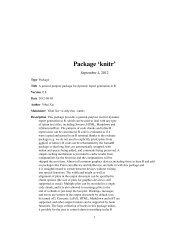Package 'openair'
Package 'openair'
Package 'openair'
You also want an ePaper? Increase the reach of your titles
YUMPU automatically turns print PDFs into web optimized ePapers that Google loves.
92 polarPlotDescriptionFunction for plotting pollutant concentration in polar coordinates showing concentration by windspeed (or another numeric variable) and direction. Mean concentrations are calculated for windspeed-direction ‘bins’ (e.g. 0-1, 1-2 m/s,... and 0-10, 10-20 degrees etc.). To aid interpretation, gamsmoothing is carried out using mgcv.UsagepolarPlot(mydata, pollutant = "nox", x = "ws", wd = "wd",type = "default", statistic = "mean",resolution = "normal", limits = NA,exclude.missing = TRUE, uncertainty = FALSE,percentile = NA, cols = "default", min.bin = 1,upper = NA, angle.scale = 315, units = x,force.positive = TRUE, k = 100, normalise = FALSE,key.header = "", key.footer = pollutant,key.position = "right", key = TRUE, auto.text = TRUE,...)ArgumentsmydatapollutantxwdtypeA data frame minimally containing wd, another variable to plot in polar coordinates(the default is a column “ws” — wind speed) and a pollutant. Should alsocontain date if plots by time period are required.Mandatory. A pollutant name corresponding to a variable in a data frame shouldbe supplied e.g. pollutant = "nox". There can also be more than one pollutantspecified e.g. pollutant = c("nox", "no2"). The main use of usingtwo or more pollutants is for model evaluation where two species would be expectedto have similar concentrations. This saves the user stacking the data andit is possible to work with columns of data directly. A typical use would bepollutant = c("obs", "mod") to compare two columns “obs” (the observations)and “mod” (modelled values).Name of variable to plot against wind direction in polar coordinates, the defaultis wind speed, “ws”.Name of wind direction field.type determines how the data are split i.e. conditioned, and then plotted. Thedefault is will produce a single plot using the entire data. Type can be one ofthe built-in types as detailed in cutData e.g. “season”, “year”, “weekday” andso on. For example, type = "season" will produce four plots — one for eachseason.It is also possible to choose type as another variable in the data frame. If thatvariable is numeric, then the data will be split into four quantiles (if possible)and labelled accordingly. If type is an existing character or factor variable, thenthose categories/levels will be used directly. This offers great flexibility for understandingthe variation of different variables and how they depend on oneanother.
















